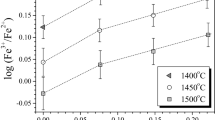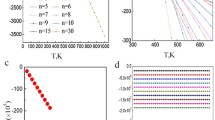Abstract
The structures of a series of Na2O–FeO–Fe2O3–SiO2 melts with Si/Fe = 1, 2, or 3 have been characterized via synchrotron X-ray total scattering using aerodynamic levitation, a containerless technique, paired with laser heating. The melt structure has been simulated using empirical potential structure refinement (EPSR) based on X-ray scattering data and molecular dynamics (MD) simulations with effective partial charge potentials. Pair distribution functions and coordination numbers of cations in the melt were obtained from the data refinement and from the MD simulations. Iron redox and accompanying density were modeled for each composition assuming either (1) oxidized (all Fe3+) or (2) reduced (some Fe2+) to the level predicted for the Ar levitator environment from a literature model. The actual redox of the melts appears to be intermediate, with some Fe2+ but not as much as assumed from the literature model of redox. Comparison of EPSR and MD models at the same redox conditions indicates generally good agreement, and precise values of coordination numbers depend sensitively on the assumptions for cutoff lengths. Stepwise cooling of each melt in the series resulted in formation of magnetite on the free surface of the sample, but no silica-containing crystalline phases were observed. This study provides a comprehensive assessment of coupled factors (composition, redox, density) needed to assess high-temperature in situ structural measurements of simplified iron silicates.








Similar content being viewed by others
References
Drewitt J, Sanloup C, Bytchkov A, Brassamin S, Hennet L (2013) Structure of (FexCa(1–x))O)y(SiO2)(1-y) liquids and glasses from high-energy x-ray diffraction: Implications for the structure of natural basaltic magmas. Phys Rev B 87:224201–224210
Waychunas GA, Brown GE, Ponader CW, Jackson WE (1988) Evidence from X-ray absorption for network-forming Fe2+ in molten alkali silicates. Nature 332:251–253
Waseda Y, Waseda Y, Shiraishi Y, Toguri J (1979) The structure of the molten FeO-Fe2O3-SiO2 system. J Jpn Inst Met 43:1099–1108
Alderman OLG, Lazareva L, Wilding MC, Benmore CJ, Heald SM, Johnson CE, Johnson JA, Hah HY, Sendelbach S, Tamalonis A, Skinner LB, Parise JB, Weber JKR (2017) Local structural variation with oxygen fugacity in Fe2SiO4+x fayalitic iron silicate melts. Geochim Cosmochim Acta 203:15–36
Neuville D, Hennet L, Florian P, de Ligny D (2014) In situ high-temperature experiments. Rev Mineral Geochem 78:779–800
Giuli G, Paris E, Hess K-U, Dingwell DB, Cicconi MR, Eeckhout SG, Fehr KT, Valenti P (2011) XAS determination of the Fe local environment and oxidation state in phonolite glasses. Am Mineral 96:631–636
Losq CL, Cicconi MR, Neuville D (2020) Iron in silicate glasses and melts: implications for volcanological processes. ESSOAr. https://doi.org/10.1002/essoar.10503261.1
Mysen B, Richet P (2005) Silicate glasses and melts: properties and structure. Elsevier, Amsterdam
Di Genova D, Zandona A, Deubener J (2020) Unravelling the effect of nano-heterogeneity on the viscosity of silicate melts: Implications for glass manufacturing and volcanic eruptions. J Non-Cryst Solids 545:120248
Ahmadzadeh M, Scrimshire A, Mottram L, Stennett MC, Hyatt NC, Bingham PA, McCloy JS (2020) Structure of NaFeSiO4, NaFeSi2O6, and NaFeSi3O8 glasses and glass-ceramics. Am Mineral 105:13875–11384
Ahmadzadeh M, Marcial J, McCloy J (2017) Crystallization of iron-containing sodium aluminosilicate glasses in the NaAlSiO4-NaFeSiO4 join. J Geophys Res Solid Earth 122:2504–2524
Peterson RA, Buck EC, Chun J, Daniel RC, Herting DL, Ilton ES, Lumetta GJ, Clark SB (2018) Review of the scientific understanding of radioactive waste at the U.S DOE Hanford Site. Environ Sci Technol 52:381–396
Goel A, McCloy JS, Pokorny R, Kruger AA (2019) Challenges with vitrification of Hanford High-Level Waste (HLW) to borosilicate glass–an overview. J Non-Cryst Solids X 4:100033
Guillen DP, Lee S, Hrma P, Traverso J, Pokorny R, Klouzek J, Kruger AA (2020) Evolution of chromium, manganese and iron oxidation state during conversion of nuclear waste melter feed to molten glass. J Non-Cryst Solids 531:119860
Pegg I (2015) Behavior of technetium in nuclear waste vitrification processes. J Radioanal Nucl Chem 305:1–6
Cicconi MR, Le Losq C, Moretti R, Neuville DR (2020) Magmas are the largest repositories and carriers of earth’s redox processes. Elements 16:173–178
Farges F, Lefrère Y, Rossano S, Berthereau A, Calas G, Brown GE Jr (2004) The effect of redox state on the local structural environment of iron in silicate glasses: a combined XAFS spectroscopy, molecular dynamics, and bond valence study. J Non-Cryst Solids 344:176–188
Farges F, Rossano S, Lefrère Y, Wilke M, Brown GEJ (2005) Iron in silicate glasses: a systematic analysis of pre-edge, XANES and EXAFS features. Physica Scripta 2005:957–959
Liu Q, Lange RA (2006) The partial molar volume of Fe2O3 in alkali silicate melts: Evidence for an average Fe3+ coordination number near five. Am Mineral 91:385–393
Alderman OLG, Wilding MC, Tamalonis A, Sendelbach S, Heald SM, Benmore CJ, Johnson CE, Johnson JA, Hah HY, Weber JKR (2017) Iron K-edge X-ray absorption near-edge structure spectroscopy of aerodynamically levitated silicate melts and glasses. Chem Geol 453:169–185
Cicconi MR, Giuli G, Ertel-Ingrisch W, Paris E, Dingwell DB (2015) The effect of the [Na/(Na+K)] ratio on Fe speciation in phonolitic glasses. Am Mineral 100:1610–1619
Le Losq C, Moretti R, Oppenheimer C, Baudelet F, Neuville DR (2020) In situ XANES study of the influence of varying temperature and oxygen fugacity on iron oxidation state and coordination in a phonolitic melt. Contrib Mineral Petrol 175:64
Le Losq C, Berry AJ, Kendrick MA, Neuville DR, O’Neill HSC (2019) Determination of the oxidation state of iron in Mid-Ocean Ridge basalt glasses by Raman spectroscopy. Am Mineral 104:1032–1042
Saloman EB, Hubbell JH, Scofield JH (1988) X-ray attenuation cross sections for energies 100 eV to 100 keV and elements Z = 1 to Z = 92. Nucl Data Sheets 53:1–196
Thomas D, Weigel C, Cormier L, Galoisy L, Calas G, Bowron D, Beuneu B (2006) Determination of Fe3+ sites in a NaFeSi2O6 glass by neutron diffraction with isotopic substitution coupled with numerical simulation. Appl Phys Lett 89:141911–141913
Weigel C, Cormier L, Calas G, Galoisy L, Bowron DT (2008) Nature and distribution of iron sites in a sodium silicate glass investigated by neutron diffraction and EPSR simulation. J Non-Cryst Solids 354:5378–5385
Benmore CJ (2012) A review of high-energy X-ray diffraction from glasses and liquids. ISRN Mater Sci 2012:852905
Hannon AC (2015) Neutron Diffraction Techniques for Structural Studies of Glasses. In: Affatigato M (ed) Modern glass characterization. American Ceramic Society & Wiley, Hoboken, New Jersey, pp 158–240
Wilding M, Benmore C, Weber R, Alderman O, Tamalonis A, McMillan PF, Wilson M, Ribiero MCC, Parise J (2019) Exploring the structure of glass-forming liquids using high energy X-ray diffraction, containerless methodology and molecular dynamics simulation. J Non-Cryst Solids X 3:100027–100027
Keen D (2001) A comparison of various commonly used correlation functions for describing total scattering. J Appl Cryst 34:172–177
Nienhuis ET, Saleh M, Marcial J, Kriegsman K, Lonergan J, Lipton AS, Guo X, McCloy JS (2019) Structural characterization of ZnSO4-K2SO4-NaCl glasses. J Non-Cryst Solids 524:119639
Marcial J, McCloy J (2019) Role of short range order on crystallization of tectosilicate glasses: a diffraction study. J Non-Cryst Solids 505:131–143
Price DL (2010) High-temperature levitated materials. Cambridge University Press, Cambridge, New York
Weber JKR, Benmore CJ, Jennings G, Wilding MC, Parise JB (2010) Instrumentation for fast in-situ X-ray structure measurements on non-equilibrium liquids. Nucl Instr Meth A 624:728–730
Hammersley AP, Svensson SO, Thompson A (1994) Calibration and correction of spatial distortions in 2D detector systems. Nucl Instrum Methods Phys Res A 346:312–321
Soper A (2011) GudrunN & GudrunX: Programs for correcting raw neutron and X-ray diffraction data to differential scattering cross section, Rutherford Appleton Laboratory Technical Report
Jayasuriya KD, O’Neill HSC, Berry AJ, Campbell SJ (2004) A Mössbauer study of the oxidation state of Fe in silicate melts. Am Mineral 89:1597–1609
Sigurdsson H (2000) Encyclopedia of volcanoes. Academic Press, San Diego, San Diego
Du J, Cormack AN (2004) The medium range structure of sodium silicate glasses: a molecular dynamics simulation. J Non-Cryst Solids 349:66–79
Sun W, Du J (2019) Interfacial structures of spinel crystals with borosilicate nuclear waste glasses from molecular dynamics simulations. J Am Ceram Soc 102:4583–4601
Deng L, Du J (2019) Development of boron oxide potentials for computer simulations of multicomponent oxide glasses. J Am Ceram Soc 102:2482–2505
Du J, Corrales LR (2006) Compositional dependence of the first sharp diffraction peaks in alkali silicate glasses: A molecular dynamics study. J Non-Cryst Solids 352:3255–3269
Du J (2019) Molecular dynamics simulations of oxide glasses. In: Musgraves JD, Hu J, Calvez L (eds) Springer Handbook of Glass. Springer Nature, Switzerland, pp 1129–1151
Soper AK (1998) Determination of the orientational pair correlation function of a molecular liquid from diffraction data. J Mol Liq 78:179–200
Levy D, Giustetto R, Hoser A (2012) Structure of magnetite (Fe3O4) above the Curie temperature: a cation ordering study. Phys Chem Mineral 39:169–176
Wang Z, Cooney TF, Sharma SK (1995) In situ structural investigation of iron-containing silicate liquids and glasses. Geochim Cosmochim Acta 59:1571–1577
Cameron M, Sueno S, Prewitt CT, Papike JJ (1973) High-temperature crystal chemistry of acmite, diopside, hedenbergite, jadeite, spodumene, and ureyite. Am Mineral 58:594–618
Keppler H (1992) Crystal field spectra and geochemistry of transition metal ions in silicate melts and glasses. Am Mineral 77:62–75
Wright AC (2014) Crystalline-like ordering in melt-quenched network glasses? J Non-Crys Solids 401:4–26
Massobrio C, Pasquarello A (2001) Origin of the first sharp diffraction peak in the structure factor of disordered network-forming systems: Layers or voids? J Chem Phys 114:7976–7979
Shi Y, Neuefeind J, Ma D, Page K, Lamberson LA, Smith NJ, Tandia A, Song AP (2019) Ring size distribution in silicate glasses revealed by neutron scattering first sharp diffraction peak analysis. J Non-Cryst Solids 516:71–81
Di Genova D, Sicola S, Romano C, Vona A, Fanara S, Spina L (2017) Effect of iron and nanolites on Raman spectra of volcanic glasses: a reassessment of existing strategies to estimate the water content. Chem Geol 475:76–86
Hughes EC, Buse B, Kearns SL, Blundy JD, Kilgour G, Mader HM, Brooker RA, Balzer R, Botcharnikov RE, Di Genova D, Almeev RR, Riker JM (2018) High spatial resolution analysis of the iron oxidation state in silicate glasses using the electron probe. Am Mineral 103:1473–1486
Dvoryankina G, Pinsker Z (1960) The electron diffraction pattern investigation of Fe3O4. Dokl Akad Nauk SSSR 132:110–113
Hrma P (2010) Crystallization during processing of nuclear waste glass. J Non-Cryst Solids 356:3019–3025
Kruger AA (2013) Advances in glass formulations for hanford high-alumimum, high-iron and enhanced sulphate management in HLW streams–13000. Hanford Site (HNF), Richland
Acknowledgements
Levitation experiments were conducted at the Advanced Photon Source, Argonne National Laboratory, Argonne, IL, on beamline 6-ID-D on GUP-60502. The authors would like to thank Chris Benmore of the Advanced Photon Source and Martin Wilding of Manchester University Harwell for the assistance with the total scattering experiments, and Richard Weber of Materials Development Inc. for use of the laser hearth for sample preparation. The authors thank Scott Boroughs for help with the electron microprobe measurements. The authors also thank José Marcial for assistance with processing the total scattering data. This manuscript benefited greatly from the careful reading and comments of several reviewers.
Funding
The research was funded by the Department of Energy, Office of Environmental Management, through the Office of River Protection, Waste Treatment and Immobilization Plant Federal Project Office, contract numbers DE-EM002904 and 89304017CEM000001, under the direction of Dr. Albert A. Kruger. JD acknowledges National Science Foundation (NSF) support with the DMR Ceramics program under grant 1508001 and UNT HPC for providing computing resources.
Author information
Authors and Affiliations
Corresponding author
Ethics declarations
Conflict of interest
The authors declare that they have no conflict of interest.
Additional information
Handling Editor: Yaroslava Yingling.
Publisher's Note
Springer Nature remains neutral with regard to jurisdictional claims in published maps and institutional affiliations.
Supplementary Information
Rights and permissions
About this article
Cite this article
Nienhuis, E.T., Tuheen, M., Du, J. et al. In situ pair distribution function analysis of crystallizing Fe-silicate melts. J Mater Sci 56, 5637–5657 (2021). https://doi.org/10.1007/s10853-020-05643-x
Received:
Accepted:
Published:
Issue Date:
DOI: https://doi.org/10.1007/s10853-020-05643-x




